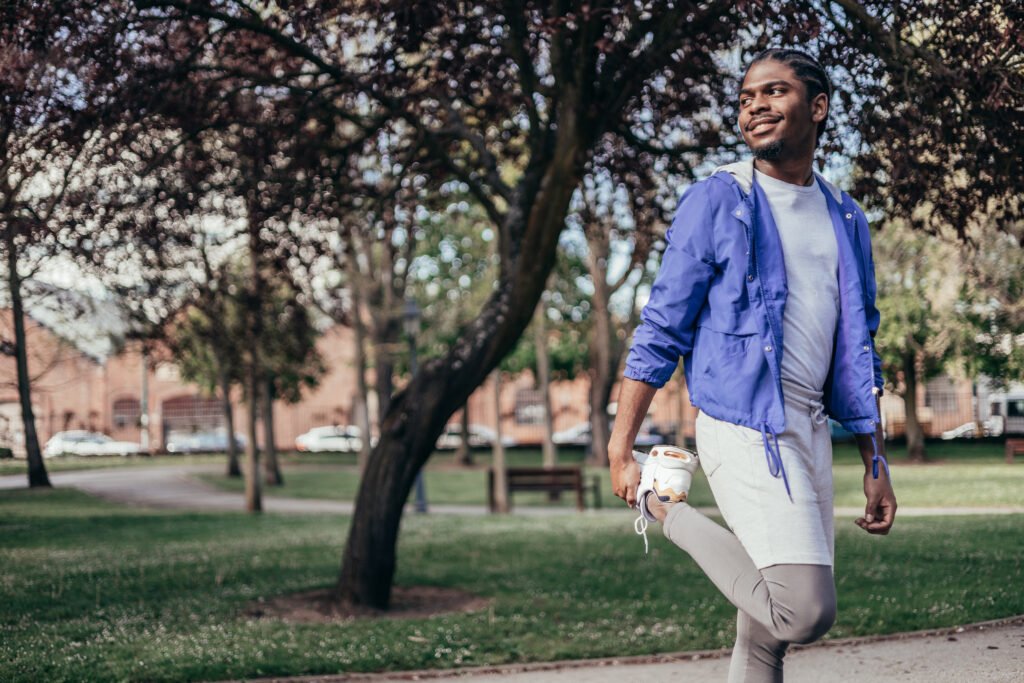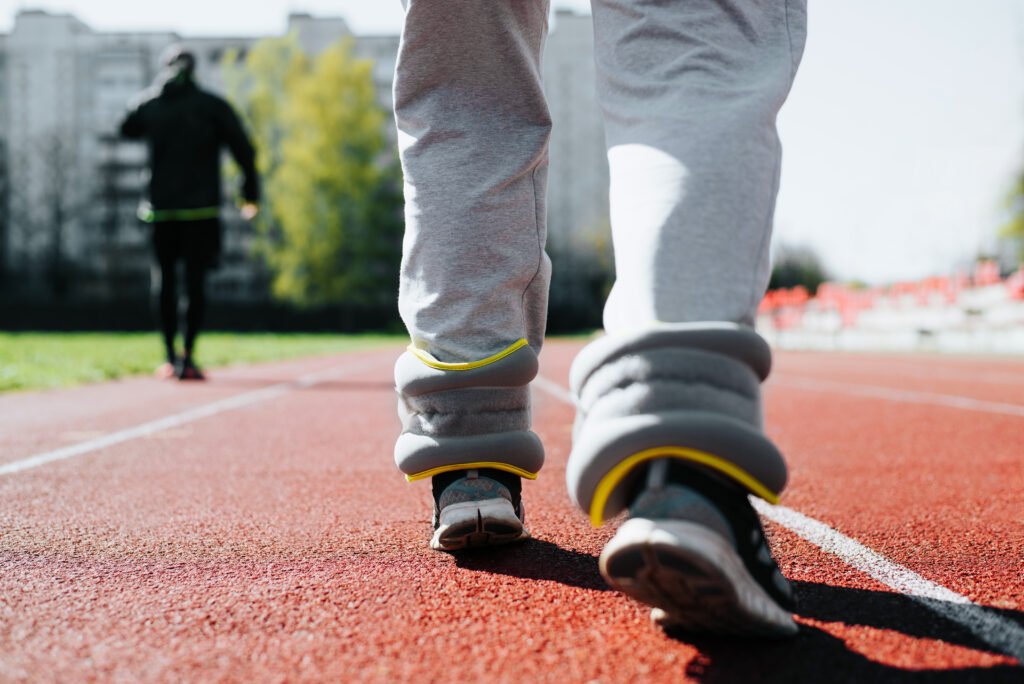1. Introduction
Brisk walking is one of the best daily exercises that anyone can practice with ease. This activity is simple, doesn’t require expensive equipment or a gym membership, and yet offers numerous benefits that positively impact overall health. In this article, we will explore how to practice brisk walking to maximize its health benefits, highlighting multiple aspects such as improved heart health, weight loss, and enhanced mental well-being.

2. Benefits of Brisk Walking for Heart Health
Brisk walking is an effective and essential exercise for supporting cardiovascular health. It’s not just a simple physical activity; it’s a powerful tool for maintaining heart function and enhancing its performance. When we walk at a fast pace, our heart rate gradually increases, helping improve blood flow and strengthen blood vessels. In this section, we’ll take an in-depth look at how brisk walking supports heart health and the primary benefits it provides to this vital organ.
A. Improved Blood Flow
One of the most notable benefits of brisk walking is its ability to enhance blood flow in the arteries and veins. Practicing this activity at a steady pace over time reduces blood pressure in blood vessels, allowing blood to flow more easily. This, in turn, lowers the risk of blood clots or the buildup of harmful cholesterol on artery walls. Brisk walking for heart health reduces resistance in arteries and improves oxygen transport to vital tissues, making the circulatory system more efficient.
B. Lowering Bad Cholesterol Levels
Research has shown that brisk walking helps lower levels of bad cholesterol (LDL) in the blood and increase levels of good cholesterol (HDL), which plays a significant role in protecting the heart. Good cholesterol reduces the buildup of harmful fats on artery walls, preventing them from narrowing, thus lowering the risk of coronary heart disease. This beneficial effect of brisk walking is a major factor in improving heart health and reducing the risks of atherosclerosis.
C. Blood Pressure Regulation
Brisk walking contributes to lowering blood pressure levels, especially when practiced regularly. People who engage in brisk walking regularly are more likely to naturally regulate their blood pressure. As blood flow increases throughout the body, blood vessels become more flexible, reducing the pressure on their walls. This lessens the risk of chronic high blood pressure, a major cause of heart disease. Brisk walking can also help the body cope with daily stress, which positively impacts blood pressure.
D. Enhancing Heart Endurance
When brisk walking is practiced daily, the heart’s endurance level significantly improves. This means the heart becomes stronger and more efficient at pumping blood. This improvement in heart strength is essential for individuals looking to boost their physical capacity and handle daily stress with greater ease. Brisk walking for heart health strengthens the heart muscle, making it more efficient, and reduces the effort needed to maintain sufficient blood flow.
E. Preventing Heart Attacks and Strokes
Heart attacks and strokes are among the leading causes of death worldwide, and their occurrence is directly linked to declining heart health. Committing to brisk walking regularly significantly reduces the risk of these severe conditions. Brisk walking for heart health helps reduce stress levels in blood vessels and minimizes the chances of arterial blockage. It also enhances arterial wall flexibility, which helps prevent the formation of blood clots that may lead to a stroke.
F. Improving Mental Health and Heart Health
Chronic stress is a major risk factor for heart disease. Brisk walking improves mental health by stimulating the release of happiness hormones like serotonin and endorphins. These hormones help reduce stress and anxiety levels, which in turn alleviates pressure on the heart and blood vessels. Thus, brisk walking for heart health not only benefits vital organs directly but also enhances mental health, an integral component of heart health.

3. The Role of Brisk Walking in Weight Loss
Brisk walking is one of the best simple exercises available to everyone, which significantly contributes to weight loss and maintaining a healthy weight. While many people believe that only intense workouts are effective in weight loss, brisk walking can have a substantial impact if done regularly. In this section, we will explore how brisk walking affects weight loss and the mechanisms through which it contributes to this goal.
A. Increased Calorie Burn
When engaging in brisk walking, the body’s calorie-burning rate increases significantly. According to several studies, a person walking at a speed of 4 to 6 miles per hour can burn between 240 to 350 calories per hour, depending on their weight and walking speed. This means that incorporating brisk walking into the daily routine can be an effective way to burn more calories, leading to eventual weight loss.
B. Boosting Metabolism
Brisk walking is known to enhance the body’s metabolic rate. When walking briskly, the body is encouraged to burn fat more effectively. An increased metabolic rate means the body requires more energy, causing it to burn calories even after the workout. This effect is especially important for weight loss, as it allows the body to continue burning fat after exercise, contributing to better results.
C. Impact on Visceral Fat
Visceral fat is the fat that accumulates around internal organs and is considered one of the most dangerous types of fat for health. Brisk walking particularly helps reduce this fat, which is closely linked to many chronic diseases such as type 2 diabetes and heart disease. By committing to a daily brisk walking program, individuals can achieve noticeable reductions in visceral fat, thereby improving their overall health.
D. Building Muscle Mass
When walking at a fast pace, multiple muscles in the body are activated. This helps enhance muscle mass, which in turn increases the basal metabolic rate. The more muscle mass one has, the higher the rate of calorie burning, even at rest. Therefore, brisk walking not only helps burn calories during exercise but also increases the body’s efficiency in burning fat over time.
E. Appetite Control
Some studies have shown that brisk walking can help control appetite, making the weight loss process easier. For example, you may experience less hunger after a brisk walking session, which helps reduce calorie intake. By incorporating brisk walking into your daily lifestyle, you might find yourself eating less, contributing to natural weight loss.
F. Supporting Healthy Habits
Brisk walking encourages a healthy lifestyle overall. People who walk regularly tend to make better food choices, such as opting for healthy foods instead of fast food. By establishing the habit of brisk walking, you may also adopt other healthy habits like drinking enough water and getting adequate sleep, all of which contribute to supporting weight loss.
G. Positive Mood Effects
Brisk walking can improve mood and reduce stress, which in turn influences eating habits. People who experience stress or depression may turn to food as a way to cope with their emotions. By engaging in brisk walking, you can improve your mood and alleviate stress, helping you avoid overeating or turning to unhealthy foods.
H. Achieving Sustainable Weight Loss Goals
Successful weight loss requires commitment and consistency. Brisk walking can be an essential part of a sustainable weight loss plan, as it can be done anywhere and at any time, making it a flexible and enjoyable activity. Due to its accessibility, people can easily incorporate brisk walking into their daily lives, helping them achieve weight loss goals gradually.

4. Improving Energy Levels and Productivity Through Brisk Walking
Brisk walking is an effective way to boost energy levels and productivity, a simple activity that can be easily integrated into the daily routine. In this section, we will discuss how brisk walking affects energy levels and how it can contribute to improving productivity in daily life.
A. Increased Energy Levels
When walking briskly, the body begins to pump more blood and oxygen to the muscles and tissues. This increased blood flow enhances the body’s supply of nutrients and improves the cells’ ability to produce energy. It is believed that this effect is due to the increased release of happiness hormones such as endorphins, which work to improve mood and boost overall energy. Therefore, you will feel more active and energized after a brisk walking session.
B. Reducing Fatigue and Exhaustion
Fatigue and exhaustion are some of the biggest factors affecting energy levels and productivity. However, brisk walking can help reduce feelings of tiredness by improving circulation and alleviating stress. For example, when you feel tired during the day, a short brisk walk can help refresh your energy and motivate you to continue with your tasks. Research suggests that just 10 minutes of walking can help improve mood and increase energy.
C. Improving Focus and Attention
Brisk walking also helps enhance focus and attention. When the brain receives more oxygen and nutrients, its performance improves, which positively impacts your ability to concentrate and make decisions. Studies indicate that individuals who engage in physical activities like brisk walking tend to perform better in thinking and focus tasks compared to those who lack physical activity. Thanks to these benefits, you can enjoy better performance at work or school.
D. Boosting Creativity
In addition to improving focus and attention, brisk walking can enhance creativity. Numerous studies have shown that physical activity can stimulate creative thinking and lead to new ideas. This is because walking allows your mind to relax, helping you think more freely. So, if you’re looking for solutions to a problem or want to come up with new ideas, you may find that going for a brisk walk opens up new perspectives.
E. Improving Mood
Research shows that physical activity, including brisk walking, contributes to reducing feelings of anxiety and depression. These improvements in mood directly affect energy levels and productivity. When a person feels happy and positive, they are more motivated to work and achieve goals. Therefore, integrating brisk walking into your daily routine can positively affect your mental and emotional health, which boosts energy and productivity levels.
F. Strengthening Social Relationships
Walking briskly with friends or colleagues can be a great way to strengthen social relationships, leading to improved productivity. Informal meetings during walks enhance communication and help in exchanging ideas casually. This type of activity strengthens social bonds, creating a positive work environment. As a result, this can positively impact productivity.
G. Improving Sleep Quality
There is a strong connection between physical activity and sleep quality. People who exercise regularly, such as brisk walking, tend to sleep better. Good sleep, in turn, is key to increasing energy levels during the day. By improving sleep quality, you can wake up feeling more active and ready to face the challenges of the day.
H. Balancing Work and Rest Time
Your daily routine should include time for both rest and physical activity. Allocating specific times for brisk walking during long work periods is an effective way to improve productivity. This can lead to increased focus after breaks, as a short walk is a great way to refresh and re-energize.

5. The Impact of Fast Walking on Mental Health and Stress Relief
Fast walking is one of the simplest activities that provides numerous benefits for mental health, as it effectively contributes to improving mood and alleviating stress and anxiety. In this section, we will explore how fast walking can positively impact mental health and present scientific evidence supporting these benefits.
Mood Improvement
Fast walking is an effective way to improve mood. When engaging in this type of physical activity, the secretion of happiness hormones such as endorphins and serotonin increases. These hormones help foster feelings of happiness and well-being. Studies show that even walking for 30 minutes can result in a noticeable improvement in mood, making you feel happier and more energetic. Therefore, incorporating fast walking into your daily routine is a simple way to achieve significant improvements in your mental state.
Reducing Stress and Anxiety
Fast walking also helps alleviate feelings of stress and anxiety. When you engage in this physical activity, blood flow to the brain is stimulated, which reduces cortisol levels, the hormone associated with stress. Research has shown that people who regularly walk are less likely to experience anxiety and stress compared to those who don’t engage in any physical activity. So, when you feel stressed, try taking a quick walk and notice how your mood improves.
Increasing Focus
Not only does fast walking improve mood, but it also helps enhance focus and attention. Studies have shown that physical activity, including walking, stimulates electrical activity in the brain, which aids in improving mental performance. Therefore, if you struggle with concentration or find yourself distracted, fast walking is an effective way to boost focus and stimulate creative thinking.
Social Interaction
Fast walking can also be an opportunity for social interaction, contributing to better mental health. Walking with friends or family members not only improves the quality of the time spent together but can also lead to improved mood and a sense of belonging. These social connections enhance emotional support and reduce feelings of loneliness, which positively impacts mental health.
Reducing Depression
Research has proven that fast walking can help reduce symptoms of depression. Regular physical activity stimulates the production of brain chemicals that improve mood, which can reduce feelings of sadness and anxiety. Studies indicate that individuals who walk regularly report lower levels of depression. Therefore, fast walking is an effective way to manage depression and face mental challenges.
Enhancing Overall Mental Health
By improving mood, reducing stress, increasing focus, and fostering social connections, it can be said that fast walking enhances overall mental health. Engaging in this activity regularly helps build a healthy and sustainable lifestyle that supports mental well-being. So, make fast walking part of your daily routine and get ready to reap its numerous benefits.
Practicing Meditation While Walking
One way to enhance the mental benefits of fast walking is by practicing meditation during your walk. You can focus on your breath, observe your surroundings, or think positive thoughts. This type of meditation helps calm the mind and reduce feelings of anxiety and stress. You can set a specific time for walking and meditating simultaneously, which will enhance your experience overall.

6. Enhancing Physical Fitness and Increasing Endurance
Physical fitness and endurance are essential elements for overall health and quality of life. In this context, fast walking comes as one of the best exercises to improve physical fitness and increase endurance. The benefits of fast walking go beyond being just a daily activity; it significantly affects the body’s capabilities and contributes to better overall health. In this section, we will discuss how fast walking can contribute to enhancing physical fitness and increasing endurance, while incorporating some transition words to facilitate understanding and communication.
Improving Cardiovascular Health
First, fast walking is an excellent exercise for the heart and cardiovascular system. When we engage in fast walking, our heart rate increases, helping improve heart efficiency. In fact, studies show that regular fast walking can reduce the risk of heart disease. Therefore, this simple activity is an effective way to improve heart health and enhance endurance.
Moreover, fast walking can help improve circulation in the body. The improved blood flow delivers oxygen and nutrients to the muscles, enabling them to function efficiently. So, if you’re looking for a way to boost your physical fitness, don’t hesitate to incorporate fast walking into your daily routine.
Increasing Muscle Strength
In addition to improving heart health, fast walking also contributes to increasing muscle strength. When you walk quickly, several muscle groups in the body are engaged, including the legs, thighs, hips, and core muscles. This helps strengthen these muscles, which enhances your ability to perform daily activities more easily.
For example, you may notice that your ability to climb stairs or carry heavy items has improved thanks to regular fast walking. This increase in muscle strength benefits your daily life and makes you feel more energetic and active.
Enhancing Endurance
When we talk about endurance, fast walking is one of the best ways to increase the body’s ability to withstand prolonged physical activity. With regular practice, your muscles begin to adapt to the effort, increasing their ability to work for longer periods. This means you can engage in other activities, such as running or cycling, without getting fatigued quickly.
Additionally, fast walking can improve the efficiency of your lungs. As your body trains to walk quickly, it becomes more efficient at using oxygen, which enhances endurance. As a result, you will notice a significant increase in your energy levels, allowing you to perform other physical activities more effectively.
Improving Flexibility and Balance
Fast walking is also a great way to enhance flexibility and balance. When you walk quickly, your joints and muscles are activated, helping maintain the flexibility of your body. Improved flexibility can reduce the risk of injuries when engaging in other activities.
Additionally, fast walking is beneficial for improving balance. Maintaining good balance is essential for overall health, especially as we age. Through regular fast walking, your balance skills can be enhanced, making movement smoother and safer.
Supporting the Immune System
It’s worth noting that fast walking also contributes to boosting the immune system. Research shows that regular physical activity, such as fast walking, can help strengthen the immune system. This means you reduce your chances of getting sick.
When the immune system is strong, the body is better able to fight off infections and diseases. So, integrating fast walking into your lifestyle helps improve your health overall, supporting physical fitness and increasing your endurance.
Psychological Impact
The benefits of fast walking aren’t limited to physical aspects; they also include psychological benefits. When you walk regularly, you experience improvements in energy levels and concentration. This, in turn, boosts motivation to maintain an active and healthy lifestyle.
Overall, the benefits of fast walking are comprehensive and positively impact both physical fitness and endurance. Integrating this activity into your daily routine helps improve overall health, making you feel more comfortable and energized. Therefore, don’t hesitate to make fast walking a part of your daily life to achieve the best results in enhancing your physical fitness and increasing your endurance.

- Suitable Times and Places for Fast Walking
The times and places for fast walking are crucial elements for maximizing the benefits of this physical activity. Choosing the right time and location can significantly affect your walking experience, making it more effective and enjoyable. In this section, we will explore the best times and places for fast walking, including transitional words to enhance understanding and flow.
Best Times for Fast Walking
- Early Morning One of the best times to engage in fast walking is early in the morning. The atmosphere is usually calm and cool, making walking easier. Additionally, starting your day with physical activity helps to energize the body and stimulate the mind. For example, fast walking in the morning can boost your energy levels, making the rest of your day more productive.
- Afternoon Similarly, the afternoon is a great time to walk briskly. Most people experience a slump after lunch, so fast walking in the afternoon can be an effective way to regain energy. Instead of reaching for an unhealthy snack, you can spend some time outdoors to move your body and refresh your mind.
- Evening Furthermore, evening hours can be a wonderful time for fast walking, especially after a long day at work. Walking in the evening is a perfect way to relax and de-stress. If you’re looking for a way to relieve daily pressures, allocating time for a brisk walk in the evening can be an excellent option.
Suitable Places for Fast Walking
- Public Parks Public parks are some of the best places for fast walking. They offer wide paths and beautiful greenery, making the experience more enjoyable. Additionally, the fresh air and quiet atmosphere in parks help improve your mood and increase your focus.
- Beaches Moreover, beaches are an ideal destination for fast walking. Walking on sand can provide an additional challenge, enhancing the benefits of the exercise. Additionally, the natural scenery at the beach offers a comfortable and motivating environment, helping you enjoy the walk and increase your activity level.
- Mountain Trails If you’re a nature lover, mountain trails are a fantastic option for fast walking. They combine physical exercise with breathtaking views, making the experience unforgettable. However, you should be prepared for varied terrain and wear appropriate footwear for comfort.
- Sports Complexes Sports complexes also make great places for fast walking, especially on hot or rainy days. These facilities offer indoor walking tracks, allowing you to maintain your activity regardless of the weather. Additionally, you can benefit from the motivating athletic atmosphere.
General Tips for Fast Walking
- Set Goals It’s important to set clear goals for fast walking. For example, you can decide on the number of minutes you plan to walk daily or the distance you want to cover. Setting goals will help you stay motivated and consistent with the activity.
- Wear Proper Clothing When fast walking, it’s essential to wear suitable clothes and shoes. Your clothes should be comfortable and light, while your shoes should provide support and be suitable for the type of terrain you’re walking on. This will help prevent injuries and increase your walking comfort.
- Use Technology Finally, you can take advantage of technology to track your progress. Many apps are available to track your distance, time, and calories burned. Using these apps can provide additional motivation to walk regularly.
- How to Integrate Fast Walking into Your Daily Routine
Fast walking is an effective way to improve both physical and mental health, but many people find it challenging to incorporate it into their daily routine. In this section, we will explore innovative and easy ways to integrate fast walking into your daily life, with transitional words for smoother content and clearer understanding.
- Set Specific Timesa. Choose the Right Time One of the first steps to integrating fast walking is to designate specific times in your day for walking. For example, you can set aside 30 minutes in the morning before work, after lunch, or even in the evening. Having designated times makes it easier to commit to regular walking.b. Use a Calendar Additionally, you can use your calendar to mark these times. By adding reminders for fast walking, you can strengthen your commitment and motivate yourself to stay active. Seeing these appointments on your calendar can also remind you of the importance of physical activity.
- Incorporate Walking into Daily Activitiesa. Walk While Commuting Furthermore, you can incorporate fast walking into your daily activities. For example, if you use public transportation, you can get off at an earlier station and walk for a few minutes. This will not only help you stay physically active but also give you a chance to explore the area around you.b. Use the Stairs Likewise, try using the stairs instead of the elevator whenever possible. Climbing stairs can be a great exercise that helps improve your fitness. This simple yet effective change can increase your daily activity level.
- Combine Walking with Social Activitiesa. Walk with Friends If you’re looking for a way to make walking more enjoyable, you can invite friends to join you. You can organize quick walks with friends in parks or along the beach. This not only strengthens social bonds but also makes physical activity an enjoyable and exciting experience.b. Join Walking Groups Additionally, you can join local walking groups. These groups provide an opportunity to exercise with like-minded individuals. The group atmosphere can provide extra motivation to stick with your daily fast walking routine.
- Set Small Goalsa. Start with Simple Goals When you begin integrating fast walking into your routine, it’s important to set small, achievable goals. For instance, you can start by walking for 10 minutes daily and gradually increase the time. This will help build confidence in your ability to maintain physical activity.b. Track Your Progress Similarly, you can track your progress using activity-tracking apps. These apps provide valuable information about the distance you’ve walked, the calories burned, and the duration of your walks. Seeing your progress can encourage you to continue your fast walking routine.
- Use Motivational Techniquesa. Music or Podcasts Listening to music or podcasts is a great way to motivate yourself during fast walking. When you listen to your favorite music or an interesting podcast episode, it can make the walking experience more enjoyable and positive. This may make you look forward to these moments in your day.b. Rewards Moreover, you can set up rewards for yourself when you reach specific goals. For example, after completing 10 fast walks, you can treat yourself to a favorite meal or leisure activity. These rewards can serve as strong motivation to maintain the routine.
- Change the Routinea. Variety in Paths To maintain enthusiasm for fast walking, it’s important to change the paths you walk on. You can explore new places, like mountain trails or beaches, to make the experience more exciting. Additionally, varying the paths prevents boredom and keeps the walk more engaging.b. Add Challenges You can also add simple challenges to your routine, like increasing your walking speed or including intervals of running. These challenges help enhance the effectiveness of the exercise and boost your fitness level.
- Common Mistakes and How to Avoid Them During Fast WalkingFast walking is a simple and effective exercise, but some practitioners make common mistakes that can impact the benefits of this activity. In this section, we will highlight the most common mistakes people make during fast walking and how to avoid them, using transitional words to increase clarity.
- Choosing the Wrong Shoesa. Importance of the Right Shoes One common mistake many people make is choosing inappropriate shoes for walking. Shoes that don’t offer enough support can lead to discomfort or injury. Therefore, it’s crucial to choose walking shoes with good cushioning and comfortable soles.b. Trying the Shoes Therefore, it’s recommended to try on shoes in the store before purchasing. Walk around the store for a bit to ensure the shoes fit well. You can also check online for reviews on the best types of walking shoes.
- Skipping Warm-Up or Stretching Before Walkinga. Importance of Warm-Up Another common mistake is not warming up or stretching before starting a fast walk. Warm-ups prepare the muscles and joints and reduce the risk of injury. Therefore, it’s important to spend a few minutes warming up before walking.b. Warm-Up Exercises You can do simple exercises like shoulder circles or leg stretches. These exercises will prepare you to walk more effectively and reduce the likelihood of injury.
- Walking at an Inappropriate Speeda. Finding the Right Walking Speed When it comes to fast walking, some people push themselves too hard, leading to exhaustion quickly. Walking too fast can be ineffective or even dangerous. So, it’s essential to choose a speed that matches your fitness level.b. Listen to Your Body Therefore, listen to your body and try to maintain a pace that allows you to talk without difficulty. As you become fitter, you can gradually increase your speed.
- Not Maintaining Proper Posturea. Importance of Proper Posture Another common mistake is not maintaining the correct posture while walking. Walking with a hunched back or raised shoulders can cause discomfort. Therefore, it’s essential to maintain an upright posture.b. Improving Posture Try to stand tall, pull your shoulders back, and relax. Your head should be up, with a focus on the horizon. This proper posture will help you enjoy the walking experience better.
- Not Varying Your Routesa. Risk of Boredom Walking the same route repeatedly can lead to boredom, reducing your motivation to continue. Therefore, it’s important to vary the paths you take.b. Exploring New Places Explore different routes, such as parks, beaches, or even city streets. Changing your routes will keep walking interesting and enjoyable.
Conclusion In conclusion, fast walking is an excellent way to improve your overall health, but it’s important to avoid common mistakes that can hinder your progress. By following these tips, you’ll be able to enjoy the benefits of fast walking and make it an essential part of your daily routine.

